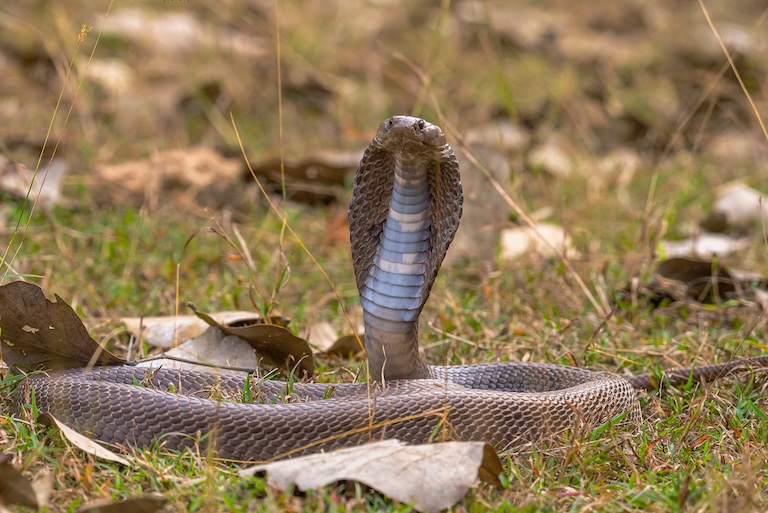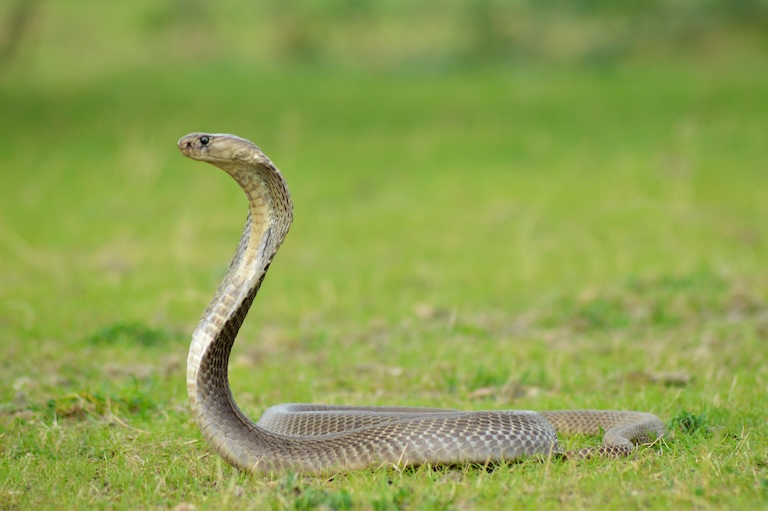Indian Cobra Profile
There are some animals that are so scary, that humans have bowed to them for millennia, bestowing a level of respect and admiration that can only be earned by a rival most worthy. These animals are usually a mix of beauty and lethality (nobody’s worshipping the mosquito), and as such, they make their way into legends that predate written records and persist today.
On the Indian subcontinent, alongside tigers and elephants, sits the Indian, or spectacled, cobra; a stunning, yet almost mythical creature that’s likely killed more people than almost any other vertebrate.

Indian Cobra Facts Overview
| Habitat: | Varied except desert: forests, wetlands, plains, agricultural, urban |
| Location: | Indian Subcontinent: India, Pakistan, Sri Lanka, Bangladesh, Nepal |
| Lifespan: | Up to 24 years in captivity |
| Size: | Up to 2.5 meters (7.4 feet) long |
| Weight: | Around 3.5kg (7.7lb) |
| Colour: | Usually brown, sometimes black with eye-like marks on hood |
| Diet: | Rodents and other mall mammals, lizards and frogs |
| Predators: | Humans |
| Top Speed: | At least (7mph |
| No. of Species: | 1 |
| Conservation Status: | Least Concern (IUCN) |
The human relationship with this snake has come at a significant cost to the animal too. Snake charmers routinely abuse live animals, and others are killed for their beautifully patterned skin.
And in return, humans are killed in alarming numbers, too. This is one of the most lethal snake species in the world, not only due to its venom, but also because of its overlapping habitat with densely-populated human areas.
Interesting Indian Cobra Facts
1. They’re one of the Big Four
India loses tens of thousands of people a year to snake bites, and this represents 80% of the global snake deaths.
This is an incredible statistic, no doubt skewed by the lack of reliable hospital data from poorer countries, but still makes a clear statement that there is something about the situation in India that seems to promote human/wildlife conflict with snakes.
Of the snakes responsible for these deaths, the [Russel’s viper] is the most common. 43% of confirmed cases are attributed to this species. 18% are due to the common krait and sitting just behind this one is the Indian Cobra, responsible for 12% of fatalities. The [Saw-scaled viper] is the fourth most common culprit. In one survey in India, the Indian cobra made up 40% of venomous snake bites.
It’s worth noting that 26% of these deaths are from unknown species, so the true figures could be different, but the picture that these statistics paint is clear. 1

2. But they’re shy
These snakes certainly cause a lot of trouble for the human population, but usually under great duress. Bites are almost always a result of a clumsy interaction between a farmer’s foot and a fleeing snake, and there’s no telling how many of those bites go unreported and don’t cause a lot of damage.
The Indian cobra is one of the snakes known to give ‘dry’ or ‘mock’ bites as a way of scaring the bejeezus out of the attacker without wasting any venom. All things considered, the cobra would much rather be on its way than get into a fight, and they’re known to be elusive and avoidant in the presence of people, rather than overly aggressive.
The trouble comes from four main factors: the overlapping habitat, the fact that these habitats are remote and far from treatment, the scary potency of the venom delivered and the fact that they’re active in the low-light hours, before and after nighttime.
Other bites come from poor handling, either by hunters or rescuers. These are particularly long snakes, and this makes them hard to handle safely.
And sadly, when a cobra bites, there are often terrifying consequences. 2
3. Their venom is a neurotoxin
Cobra venom differs from viper venom in that it primarily affects the nerves, via a toxin known as cobratoxin. This makes bites from the species likely to cause widespread paralysis and death if left untreated.
Because of this, advice for what to do in case of a bite is mixed. While most sources recommend against tying off the bitten area with a tourniquet, this is far more important advice with cytotoxins that damage tissues, as it concentrates their effect, often resulting in the loss of a limb.
With neurotoxins, the more localised the venom stays, the longer the patient may have to receive treatment. For Naja naja, common advice is to bandage the limb as tight as you would bandage a broken bone, for this reason.
4. It has potential medical applications
The cobratoxin from species in this genus has been shown to produce analgesic, or pain-killing effects and may be used to inspire a new class of analgesic drugs.
The nerve-blocking nature of the venom could be useful in small doses, and while many strong painkillers work on the opioid system, this protein has a different mechanism of action, potentially removing a lot of the addiction risk that comes from modern painkillers.
And it’s not only doctors who have discovered the potential benefits of this chemical. 3

5. Some people get high on it
Humans love to get high. They’ve built entire civilisations and multiple religions off the back of a good trip. But when the safe stuff is either illegal or otherwise unavailable, they’re forced to resort to inventive, somewhat uncharted methods.
In India, teenagers have been found to exploit such unique intoxicants as charred lizards, toxic honey, and toxic green beetles to find their buzz, and among the literature detailing these cases is the act of getting yourself bitten on purpose by the Indian cobra.
It’s said the young snake is caught, held by the head, and encouraged – by slapping it quite rudely on the head – to bite the receiver on the end of the toe or finger.
The trick is to get just enough of the good stuff to feel a nice sense of well-being and relaxation and not so much that your organs shut down.
The inner lip and earlobe are also said to be common sites of injection, and symptoms range from lethargy to heightened arousal and euphoria. 4 5
6. A lot more die
But death is a more common response to Indian cobra bites than euphoria is, and some people last a mere 45 minutes after being bitten; not nearly long enough to find transport and get to a hospital.
This lack of access to treatment is a significant contributor to the high death count from snakes in India.
Despite this, the snakes are still hunted and pestered and interacted with in numerous ways.
7. They’re hunted
The beautiful colouration on this snake has led to a global market for its skin, which puts them on the hitlist of suppliers throughout its range to send off for handbags and shoes.
But there are also traditional ceremonial practices involving public displays of mysticism and huge cobras.
Snake charming takes advantage of the pinpoint focus of cobras to lure them into following a charmer’s pipe (known as a bean). The sound coming out of the pipe is entirely inconsequential to the snake, who can’t hear a thing, but the motion has them transfixed, and with this, the charmer can initiate a sort of dance, appearing to hypnotise the animal as part of the show.
If they’re lucky, the snake will only be hypnotised, but in many cases, they’re also defanged, or have their mouths sewn shut for the safety of the ‘charmer’. This is an irreversible process that ultimately leads to the death of the snake from starvation, at which point they’re simply replaced.
This barbaric ritual has a long-standing significance in the region, and the eyes on the hood of the cobra are said to distinguish between good and bad men; a death from a cobra bite, therefore, signifies the victim wasn’t as nice as they put on. 6
Indian Cobra Fact-File Summary
Scientific Classification
| Kingdom: | Animalia |
| Phylum: | Chordata |
| Class: | Reptilia |
| Order: | Squamata |
| Family: | Elapidae |
| Genus: | Naja |
| Species: | naja |
Fact Sources & References
- Maya Gopalakrishnan (2022), “A simple mortality risk prediction score for viper envenoming in India (VENOMS): A model development and validation study”, Plos.
- (2022), “Species: Indian Cobra”, RESQ.
- Zhi-xin CHEN (2006), “A long-form α-neurotoxin from cobra venom produces potent opioidindependent analgesia”, Blackwell Publishing.
- Mohammad Zia Ul Haq Katshu (2011), “Snake Bite as a Novel Form of Substance Abuse: Personality Profiles and Cultural Perspectives”, Sage Journals.
- Dushad Ram (2021), “Recreational use of snake venom, an emerging trend in India – A case report and review of reports”, Indian Journal of Physiology and Pharmacology.
- “Naja naja Indian Cobra”, Animal Diversity Web.
